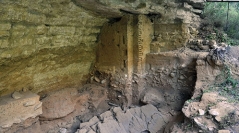

 Comptes Rendus Palevol
20 (14) - Pages 225-252
Comptes Rendus Palevol
20 (14) - Pages 225-252The La Combette rock-shelter, located in the Luberon mountains (Southern France), is an essential local archaeological discovery. The site comprises several Palaeolithic layers suggesting multiple phases of Mousterian occupation. The sediment sequence of c. 7 m thickness indicates rapid changes in the environmental conditions, which led to an abandonment of the site. While the first chronological studies were carried out in the late 1990s, in 2014, new sediment samples were taken for state-of-the-art luminescence-dating analyses using fine grain (4-11 µm) quartz and polymineral separates. Samples were taken from the loess-dominated upper archaeological levels A to D (upper main unit) as well as from the anthropogenic layer E, embedded in a fluvial context, and from the bottom deposits of the layer F/G. Here we present the obtained chronological dataset in conjunction with 24 so far unpublished thermoluminescence dating results from burnt flint artefacts from layers E and F/G. We combine and discuss our results against previous chronological datasets, which seem to be broadly confirmed by our new findings framing the sedimentation history of La Combette at 78.3 ka to 39.4 ka. In summary, it appears that the local environmental conditions were deeply impacted by the climatic changes during MIS 4/3. This caused rapid sediment influx that finally rendered the rock shelter uninhabitable as a potential refuge, until its re-discovery in the second half of the 20th century.
La Combette, Mousterian, chronology, flint, loess, luminescence dating